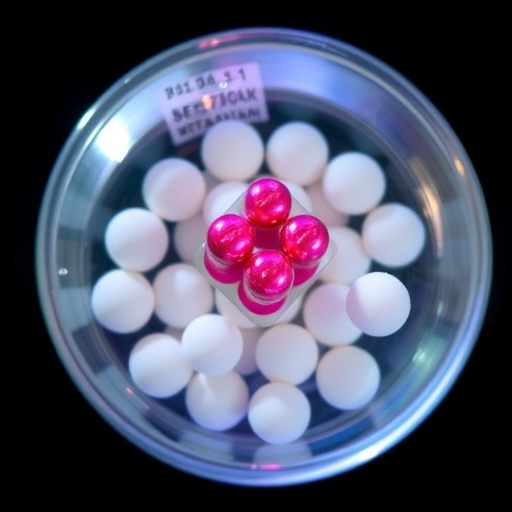In a significant advance for environmental science, researchers have unveiled a new approach to degrade levofloxacin using a novel photocatalyst, magnetic Fe₃O₄@TiO₂. This innovative combination harnesses the unique properties of both iron oxide and titanium dioxide to effectively break down this antibiotic, which has raised ecological concerns due to its persistence in water bodies. The implications of this study are profound as it tackles the issue of pharmaceutical pollution, offering a highly efficient method to cleanse contaminated water sources.
Levofloxacin, a widely used antibiotic in human and veterinary medicine, has been detected in various aquatic environments. Its presence presents a dual challenge: not only does it contribute to antibiotic resistance, but it also poses risks to aquatic life. The development of a photocatalytic system capable of degrading such pharmaceuticals is crucial. The researchers utilized magnetic Fe₃O₄ particles coated with TiO₂ to create a composite that not only decomposes levofloxacin effectively but also facilitates easy separation from wastewater after treatment.
The photocatalytic activity of the Fe₃O₄@TiO₂ composite is remarkable. Under UV light irradiation, the titanium dioxide catalyzes the photodegradation process. It generates reactive oxygen species (ROS), which are powerful oxidizing agents that can break down complex organic substances into simpler, less harmful ones. The magnetic properties of Fe₃O₄ allow for easy retrieval of the catalyst from the treated water. This feature is particularly valuable in real-world applications where reusability of catalysts plays a key role in reducing operational costs.
Preliminary tests demonstrated that under optimal conditions, the Fe₃O₄@TiO₂ photocatalyst achieved a degradation efficiency exceeding 95% for levofloxacin within a few hours. This rapid degradation is pivotal not only for effective water treatment but also represents a significant reduction in the time required for traditional degradation methods, which may not be as effective against such stable compounds. By shortening the treatment time, the process can be scaled up for industrial applications.
Mechanical insights into the degradation pathway reveal that the photocatalyst initiates reactions that lead to the mineralization of levofloxacin. This process transforms it into carbon dioxide, water, and other benign substances. The study meticulously measured by-products formed during the degradation process, identifying several intermediate compounds, some of which may also pose ecological risks. Understanding the complete degradation pathway is essential for assessing the environmental safety of the proposed method.
One of the most compelling aspects of this research is the toxicity evaluation associated with the degradation products. While photocatalysis shows promise in breaking down levofloxacin efficiently, it’s paramount to ensure that the resulting by-products do not pose a risk to human health or the environment. The researchers conducted comprehensive toxicity assays, which indicated a significant reduction in toxicity associated with levofloxacin after treatment with the Fe₃O₄@TiO₂ system.
The intersection of photocatalysis and environmental remediation exemplifies a growing trend within green chemistry aimed at developing sustainable technologies. It highlights the importance of finding alternative methods to treat contaminated water, which remains a pressing issue globally. The efficient degradation of pharmaceuticals like levofloxacin demonstrates how innovative materials can contribute to solving complex environmental problems.
Looking forward, the researchers are optimistic about the scalability of their findings. They envision applications ranging from municipal wastewater treatment facilities to industrial effluent management, particularly in areas where pharmaceutical contamination is prevalent. Their findings could inform regulatory policies aimed at reducing pharmaceutical residues in aquatic environments.
As the field continues to advance, further studies will focus on understanding the long-term stability and viability of the Fe₃O₄@TiO₂ photocatalyst under various environmental conditions. These investigations will ensure that this technology remains effective over prolonged periods and in the presence of other contaminants. The pursuit of a safe, efficient means of mitigating pharmaceutical pollution aligns well with global sustainability goals.
Ultimately, the emergence of the Fe₃O₄@TiO₂ photocatalyst as a viable solution for levofloxacin degradation invites further exploration. As scientists continue to refine their methods and broaden their research to include a wider range of contaminants, there is hope that innovative solutions will emerge to combat the complex challenges posed by environmental pollution. This study marks just the beginning, suggesting a pathway to cleaner water and a healthier planet.
In conclusion, the highly efficient degradation of levofloxacin using magnetic Fe₃O₄@TiO₂ photocatalyst represents a major step toward addressing the pressing issue of pharmaceutical pollution in aquatic environments. The collaborative, interdisciplinary efforts of researchers in this domain promise to yield practical applications that enhance water quality and better environmental stewardship. Such breakthroughs not only resonate within the scientific community but also hold significant societal implications as we strive for a cleaner and safer world.
Subject of Research: Degradation of levofloxacin using a magnetic Fe₃O₄@TiO₂ photocatalyst.
Article Title: Highly efficient degradation of levofloxacin by magnetic Fe₃O₄@TiO₂ photocatalyst: mechanistic insights and toxicity evaluation.
Article References:
Thao, T.Q., Anh, V.T.V., Nhu, L.P.Q. et al. Highly efficient degradation of levofloxacin by magnetic Fe₃O₄@TiO₂ photocatalyst: mechanistic insights and toxicity evaluation. Environ Sci Pollut Res (2025). https://doi.org/10.1007/s11356-025-37142-4
Image Credits: AI Generated
DOI: https://doi.org/10.1007/s11356-025-37142-4
Keywords: levofloxacin, photocatalysis, environmental remediation, Fe₃O₄@TiO₂, wastewater treatment, antibiotics, toxicity evaluation, sustainable technology.




